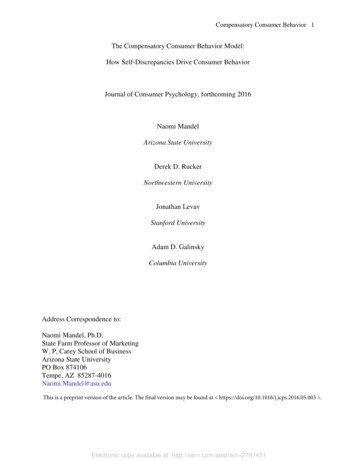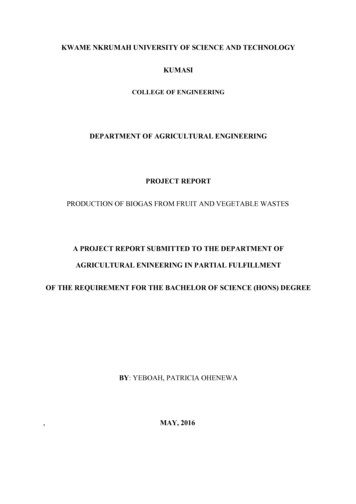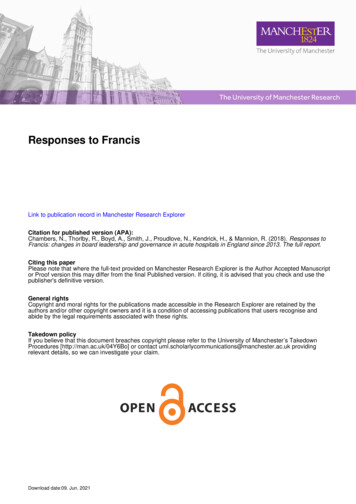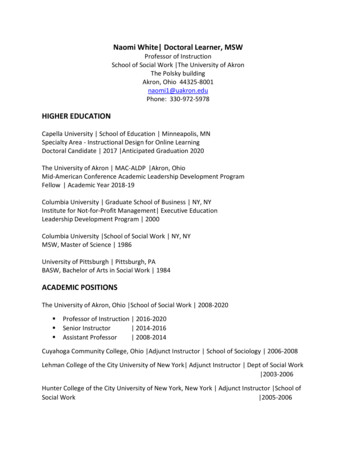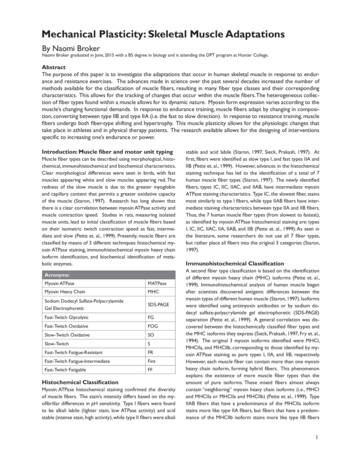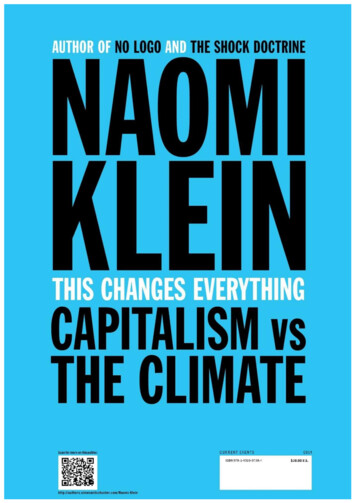
Transcription
PUBLISHED BY ALFRED A. KNOPF CANADACopyright 2014 Naomi KleinAll rights reserved under International and Pan-American CopyrightConventions. No part of this book may be reproduced in any form or by anyelectronic or mechanical means, including information storage and retrievalsystems, without permission in writing from the publisher, except by areviewer, who may quote brief passages in a review. Published in 2014 byAlfred A. Knopf Canada, a division of Random House of Canada Limited, aPenguin Random House Company, and simultaneously in the United Statesof America by Simon & Schuster, New York. Distributed in Canada BayRandom House of Canada Limited, Toronto.www.penguinrandomhouse.caKnopf Canada and colophon are registered trademarks.Library and Archives Canada Cataloguing in PublicationKlein, Naomi, authorThis changes everything : capitalism vs. the climate / Naomi Klein.Includes bibliographical references.ISBN 978-0-307-40199-1eBook ISBN 978-0-307-40202-81. Climatic changes—Economic aspects. 2. Climatic changes—Politicalaspects. 3. Climatic changes—Social aspects. 4. Capitalism. 5. Globalenvironmental change. I. Title.QC903.K64 2014363.738′74C2014-902431-2
For Toma“We need to remember that the work of our time is bigger thanclimate change. We need to be setting our sights higher and deeper.What we’re really talking about, if we’re honest with ourselves, istransforming everything about the way we live on this planet.”–Rebecca Tarbotton, Executive Director of the Rainforest Action Network,1973-20121“In my books I’ve imagined people salting the Gulf Stream, dammingthe glaciers sliding off the Greenland ice cap, pumping ocean waterinto the dry basins of the Sahara and Asia to create salt seas, pumpingmelted ice from Antarctica north to provide freshwater, geneticallyengineering bacteria to sequester more carbon in the roots of trees,raising Florida 30 feet to get it back above water, and (hardest of all)comprehensively changing capitalism.”–Science fiction writer Kim Stanley Robinson, 20122
CONTENTSCoverOther Books by This AuthorTitle PageCopyrightDedicationEpigraphIntroduction One Way or Another, Everything ChangesPART ONEBAD TIMING01. The Right Is Right: The Revolutionary Power of Climate Change02. Hot Money: How Free Market Fundamentalism Helped Overheat the Planet03. Public and Paid For: Overcoming the Ideological Blocks to the NextEconomy04. Planning and Banning: Slapping the Invisible Hand, Building a Movement05. Beyond Extractivism: Confronting the Climate Denier WithinPART TWOMAGICAL THINKING06. Fruits, Not Roots: The Disastrous Merger of Big Business and Big Green07. No Messiahs: The Green Billionaires Won’t Save Us08. Dimming the Sun: The Solution to Pollution Is Pollution?
PART THREESTARTING ANYWAY09. Blockadia: The New Climate Warriors10. Love Will Save This Place: Democracy, Divestment, and the Wins So Far11. You and What Army? Indigenous Rights and the Power of Keeping OurWord12. Sharing the Sky: The Atmospheric Commons and the Power of Paying OurDebts13. The Right to Regenerate: Moving from Extraction to RenewalConclusion The Leap Years: Just Enough Time for ImpossibleNotesAcknowledgments
IntroductionONE WAY OR ANOTHER, EVERYTHING CHANGES“Most projections of climate change presume that future changes–greenhouse gas emissions, temperature increases and effects such as sealevel rise–will happen incrementally. A given amount of emission willlead to a given amount of temperature increase that will lead to a givenamount of smooth incremental sea level rise. However, the geologicalrecord for the climate reflects instances where a relatively small changein one element of climate led to abrupt changes in the system as a whole.In other words, pushing global temperatures past certain thresholdscould trigger abrupt, unpredictable and potentially irreversible changesthat have massively disruptive and large-scale impacts. At that point,even if we do not add any additional CO2 to the atmosphere, potentiallyunstoppable processes are set in motion. We can think of this as suddenclimate brake and steering failure where the problem and itsconsequences are no longer something we can control.”—Report by the American Association for the Advancement of Science,1the world’s largest general scientific society, 2014“I love that smell of the emissions.”—Sarah Palin, 20112A voice came over the intercom: would the passengers of Flight 3935, scheduledto depart Washington, D.C., for Charleston, South Carolina, kindly collect theircarry-on luggage and get off the plane.They went down the stairs and gathered on the hot tarmac. There they sawsomething unusual: the wheels of the US Airways jet had sunk into the blackTHIS CHANGES EVERYTHING 1
pavement as if it were wet cement. The wheels were lodged so deep, in fact, thatthe truck that came to tow the plane away couldn’t pry it loose. The airline hadhoped that without the added weight of the flight’s thirty-five passengers, theaircraft would be light enough to pull. It wasn’t. Someone posted a picture: “Whyis my flight cancelled? Because DC is so damn hot that our plane sank 4″ into the3pavement.”Eventually, a larger, more powerful vehicle was brought in to tow the plane andthis time it worked; the plane finally took off, three hours behind schedule. A4spokesperson for the airline blamed the incident on “very unusual temperatures.”The temperatures in the summer of 2012 were indeed unusually hot. (As theywere the year before and the year after.) And it’s no mystery why this has beenhappening: the profligate burning of fossil fuels, the very thing that US Airwayswas bound and determined to do despite the inconvenience presented by a meltingtarmac. This irony—the fact that the burning of fossil fuels is so radically changingour climate that it is getting in the way of our capacity to burn fossil fuels—did notstop the passengers of Flight 3935 from reembarking and continuing theirjourneys. Nor was climate change mentioned in any of the major news coverageof the incident.I am in no position to judge these passengers. All of us who live high consumerlifestyles, wherever we happen to reside, are, metaphorically, passengers on Flight3935. Faced with a crisis that threatens our survival as a species, our entire cultureis continuing to do the very thing that caused the crisis, only with an extra dose ofelbow grease behind it. Like the airline bringing in a truck with a more powerfulengine to tow that plane, the global economy is upping the ante from conventionalsources of fossil fuels to even dirtier and more dangerous versions—bitumen fromthe Alberta tar sands, oil from deepwater drilling, gas from hydraulic fracturing(fracking), coal from detonated mountains, and so on.Meanwhile, each supercharged natural disaster produces new irony-ladensnapshots of a climate increasingly inhospitable to the very industries mostresponsible for its warming. Like the 2013 historic floods in Calgary that forcedthe head offices of the oil companies mining the Alberta tar sands to go dark andsend their employees home, while a train carrying flammable petroleum productsteetered on the edge of a disintegrating rail bridge. Or the drought that hit theMississippi River one year earlier, pushing water levels so low that barges loadedwith oil and coal were unable to move for days, while they waited for the ArmyCorps of Engineers to dredge a channel (they had to appropriate funds allocated torebuild from the previous year’s historic flooding along the same waterway). OrTHIS CHANGES EVERYTHING 2
the coal-fired power plants in other parts of the country that were temporarily shutdown because the waterways that they draw on to cool their machinery were eithertoo hot or too dry (or, in some cases, both).Living with this kind of cognitive dissonance is simply part of being alive in thisjarring moment in history, when a crisis we have been studiously ignoring is hittingus in the face—and yet we are doubling down on the stuff that is causing the crisisin the first place.I denied climate change for longer than I care to admit. I knew it was happening,sure. Not like Donald Trump and the Tea Partiers going on about how thecontinued existence of winter proves it’s all a hoax. But I stayed pretty hazy on thedetails and only skimmed most of the news stories, especially the really scary ones.I told myself the science was too complicated and that the environmentalists weredealing with it. And I continued to behave as if there was nothing wrong with theshiny card in my wallet attesting to my “elite” frequent flyer status.A great many of us engage in this kind of climate change denial. We look for asplit second and then we look away. Or we look but then turn it into a joke (“moresigns of the Apocalypse!”). Which is another way of looking away.Or we look but tell ourselves comforting stories about how humans are cleverand will come up with a technological miracle that will safely suck the carbon outof the skies or magically turn down the heat of the sun. Which, I was to discoverwhile researching this book, is yet another way of looking away.Or we look but try to be hyper-rational about it (“dollar for dollar it’s moreefficient to focus on economic development than climate change, since wealth isthe best protection from weather extremes”)—as if having a few more dollars willmake much difference when your city is underwater. Which is a way of lookingaway if you happen to be a policy wonk.Or we look but tell ourselves we are too busy to care about something so distantand abstract—even though we saw the water in the subways in New York City,and the people on their rooftops in New Orleans, and know that no one is safe, themost vulnerable least of all. And though perfectly understandable, this too is a wayof looking away.Or we look but tell ourselves that all we can do is focus on ourselves. Meditateand shop at farmers’ markets and stop driving—but forget trying to actually changethe systems that are making the crisis inevitable because that’s too much “badenergy” and it will never work. And at first it may appear as if we are looking,because many of these lifestyle changes are indeed part of the solution, but we stillhave one eye tightly shut.THIS CHANGES EVERYTHING 3
Or maybe we do look—really look—but then, inevitably, we seem to forget.Remember and then forget again. Climate change is like that; it’s hard to keep itin your head for very long. We engage in this odd form of on-again-off-againecological amnesia for perfectly rational reasons. We deny because we fear that5letting in the full reality of this crisis will change everything. And we are right.We know that if we continue on our current path of allowing emissions to riseyear after year, climate change will change everything about our world. Majorcities will very likely drown, ancient cultures will be swallowed by the seas, andthere is a very high chance that our children will spend a great deal of their livesfleeing and recovering from vicious storms and extreme droughts. And we don’thave to do anything to bring about this future. All we have to do is nothing. Justcontinue to do what we are doing now, whether it’s counting on a techno-fix ortending to our gardens or telling ourselves we’re unfortunately too busy to dealwith it.All we have to do is not react as if this is a full-blown crisis. All we have to dois keep on denying how frightened we actually are. And then, bit by bit, we willhave arrived at the place we most fear, the thing from which we have been avertingour eyes. No additional effort required.There are ways of preventing this grim future, or at least making it a lot less dire.But the catch is that these also involve changing everything. For us highconsumers, it involves changing how we live, how our economies function, eventhe stories we tell about our place on earth. The good news is that many of thesechanges are distinctly un-catastrophic. Many are downright exciting. But I didn’tdiscover this for a long while.I remember the precise moment when I stopped averting my eyes to the realityof climate change, or at least when I first allowed my eyes to rest there for a goodwhile. It was in Geneva, in April 2009, and I was meeting with Bolivia’sambassador to the World Trade Organization (WTO), who was then a surprisinglyyoung woman named Angélica Navarro Llanos. Bolivia being a poor country witha small international budget, Navarro Llanos had recently taken on the climateportfolio in addition to her trade responsibilities. Over lunch in an empty Chineserestaurant, she explained to me (using chopsticks as props to make a graph of theglobal emission trajectory) that she saw climate change both as a terrible threat toher people—but also an opportunity.A threat for the obvious reasons: Bolivia is extraordinarily dependent on glaciersfor its drinking and irrigation water and those white-capped mountains that towerover its capital were turning gray and brown at an alarming rate. The opportunity,THIS CHANGES EVERYTHING 4
Navarro Llanos said, was that since countries like hers had done almost nothing tosend emissions soaring, they were in a position to declare themselves “climatecreditors,” owed money and technology support from the large emitters to defraythe hefty costs of coping with more climate-related disasters, as well as to helpthem develop on a green energy path.She had recently given a speech at a United Nations climate conference in whichshe laid out the case for these kinds of wealth transfers, and she gave me a copy.“Millions of people,” it read, “in small islands, least-developed countries,landlocked countries as well as vulnerable communities in Brazil, India and China,and all around the world—are suffering from the effects of a problem to whichthey did not contribute. If we are to curb emissions in the next decade, we needa massive mobilization larger than any in history. We need a Marshall Plan for theEarth. This plan must mobilize financing and technology transfer on scales neverseen before. It must get technology onto the ground in every country to ensure we6reduce emissions while raising people’s quality of life. We have only a decade.”Of course a Marshall Plan for the Earth would be very costly—hundreds ofbillions if not trillions of dollars (Navarro Llanos was reluctant to name a figure).And one might have thought that the cost alone would make it a nonstarter—afterall, this was 2009 and the global financial crisis was in full swing. Yet the grindinglogic of austerity—passing on the bankers’ bills to the people in the form of publicsector layoffs, school closures, and the like—had not yet been normalized. Sorather than making Navarro Llanos’s ideas seem less plausible, the crisis had theopposite effect.We had all just watched as trillions of dollars were marshaled in a moment whenour elites decided to declare a crisis. If the banks were allowed to fail, we weretold, the rest of the economy would collapse. It was a matter of collective survival,so the money had to be found. In the process, some rather large fictions at the heartof our economic system were exposed (Need more money? Print some!). A fewyears earlier, governments took a similar approach to public finances after theSeptember 11 terrorist attacks. In many Western countries, when it came toconstructing the security/surveillance state at home and waging war abroad,budgets never seemed to be an issue.Climate change has never received the crisis treatment from our leaders, despitethe fact that it carries the risk of destroying lives on a vastly greater scale thancollapsed banks or collapsed buildings. The cuts to our greenhouse gas emissionsthat scientists tell us are necessary in order to greatly reduce the risk of catastropheare treated as nothing more than gentle suggestions, actions that can be put offTHIS CHANGES EVERYTHING 5
pretty much indefinitely. Clearly, what gets declared a crisis is an expression ofpower and priorities as much as hard facts. But we need not be spectators in allthis: politicians aren’t the only ones with the power to declare a crisis. Massmovements of regular people can declare one too.Slavery wasn’t a crisis for British and American elites until abolitionism turnedit into one. Racial discrimination wasn’t a crisis until the civil rights movementturned it into one. Sex discrimination wasn’t a crisis until feminism turned it intoone. Apartheid wasn’t a crisis until the anti-apartheid movement turned it into one.In the very same way, if enough of us stop looking away and decide that climatechange is a crisis worthy of Marshall Plan levels of response, then it will becomeone, and the political class will have to respond, both by making resourcesavailable and by bending the free market rules that have proven so pliable whenelite interests are in peril. We occasionally catch glimpses of this potential when acrisis puts climate change at the front of our minds for a while. “Money is no objectin this relief effort. Whatever money is needed for it will be spent,” declared Britishprime minister David Cameron—Mr. Austerity himself—when large parts of hiscountry were underwater from historic flooding in February 2014 and the public7was enraged that his government was not doing more to help.Listening to Navarro Llanos describe Bolivia’s perspective, I began tounderstand how climate change—if treated as a true planetary emergency akin tothose rising flood waters—could become a galvanizing force for humanity, leavingus all not just safer from extreme weather, but with societies that are safer andfairer in all kinds of other ways as well. The resources required to rapidly moveaway from fossil fuels and prepare for the coming heavy weather could pull hugeswaths of humanity out of poverty, providing services now sorely lacking, fromclean water to electricity. This is a vision of the future that goes beyond justsurviving or enduring climate change, beyond “mitigating” and “adapting” to it inthe grim language of the United Nations. It is a vision in which we collectively usethe crisis to leap somewhere that seems, frankly, better than where we are rightnow.After that conversation, I found that I no longer feared immersing myself in thescientific reality of the climate threat. I stopped avoiding the articles and thescientific studies and read everything I could find. I also stopped outsourcing theproblem to the environmentalists, stopped telling myself this was somebody else’sissue, somebody else’s job. And through conversations with others in the growingclimate justice movement, I began to see all kinds of ways that climate changecould become a catalyzing force for positive change—how it could be the bestTHIS CHANGES EVERYTHING 6
argument progressives have ever had to demand the rebuilding and reviving oflocal economies; to reclaim our democracies from corrosive corporate influence;to block harmful new free trade deals and rewrite old ones; to invest in starvingpublic infrastructure like mass transit and affordable housing; to take backownership of essential services like energy and water; to remake our sickagricultural system into something much healthier; to open borders to migrantswhose displacement is linked to climate impacts; to finally respect Indigenous landrights—all of which would help to end grotesque levels of inequality within ournations and between them.And I started to see signs—new coalitions and fresh arguments—hinting at how,if these various connections were more widely understood, the urgency of theclimate crisis could form the basis of a powerful mass movement, one that wouldweave all these seemingly disparate issues into a coherent narrative about how toprotect humanity from the ravages of both a savagely unjust economic system anda destabilized climate system. I have written this book because I came to theconclusion that climate action could provide just such a rare catalyst.A People’s ShockBut I also wrote it because climate change can be a catalyst for a range of verydifferent and far less desirable forms of social, political, and economictransformation.I have spent the last fifteen years immersed in research about societiesundergoing extreme shocks—caused by economic meltdowns, natural disasters,terrorist attacks, and wars. And I have looked deeply into how societies change inthese periods of tremendous stress. How these events change the collective senseof what is possible, for better but mostly for worse. As I discussed in my lastbook, The Shock Doctrine, over the past four decades corporate interests havesystematically exploited these various forms of crisis to ram through policies thatenrich a small elite—by lifting regulations, cutting social spending, and forcinglarge-scale privatizations of the public sphere. They have also been the excuse forextreme crackdowns on civil liberties and chilling human rights violations.And there are plenty of signs that climate change will be no exception—that,rather than sparking solutions that have a real chance of preventing catastrophicwarming and protecting us from inevitable disasters, the crisis will once again beseized upon to hand over yet more resources to the 1 percent. You can see the earlyTHIS CHANGES EVERYTHING 7
stages of this process already. Communal forests around the world are being turnedinto privatized tree farms and preserves so their owners can collect somethingcalled “carbon credits,” a lucrative scam I’ll explore later. There is a booming tradein “weather futures,” allowing companies and banks to gamble on changes in theweather as if deadly disasters were a game on a Vegas craps table (between 2005and 2006 the weather derivatives market jumped nearly fivefold, from 9.7billion to 45.2 billion). Global reinsurance companies are making billions inprofits, in part by selling new kinds of protection schemes to developing countriesthat have done almost nothing to create the climate crisis, but whose infrastructure8is intensely vulnerable to its impacts.And in a moment of candor, the weapons giant Raytheon explained, “Expandedbusiness opportunities are likely to arise as consumer behaviour and needs changein response to climate change.” Those opportunities include not just more demandfor the company’s privatized disaster response services but also “demand for itsmilitary products and services as security concerns may arise as results of9droughts, floods, and storm events occur as a result of climate change.” This isworth remembering whenever doubts creep in about the urgency of this crisis: theprivate militias are already mobilizing.Droughts and floods create all kinds of business opportunities besides a growingdemand for men with guns. Between 2008 and 2010, at least 261 patents were filedrelated to growing “climate-ready” crops—seeds supposedly able to withstandextreme weather conditions; of these patents close to 80 percent were controlledby six agribusiness giants, including Monsanto and Syngenta. Superstorm Sandy,meanwhile, has been a windfall for New Jersey real estate developers who havereceived millions for new construction in lightly damaged areas, while it continuesto be a nightmare for those living in hard-hit public housing, much as the aftermath10of Hurricane Katrina played out in New Orleans.None of this is surprising. Finding new ways to privatize the commons and profitfrom disaster is what our current system is built to do; left to its own devices, it iscapable of nothing else. The shock doctrine, however, is not the only way societiesrespond to crises. We have all witnessed this in recent years as the financialmeltdown that began on Wall Street in 2008 reverberated around the world. Asudden rise in food prices helped create the conditions for the Arab Spring.Austerity policies have inspired mass movements from Greece to Spain to Chileto the United States to Quebec. Many of us are getting a lot better at standing upto those who would cynically exploit crises to ransack the public sphere. And yetthese protests have also shown that saying no is not enough. If oppositionTHIS CHANGES EVERYTHING 8
movements are to do more than burn bright and then burn out, they will need acomprehensive vision for what should emerge in the place of our failing system,as well as serious political strategies for how to achieve those goals.Progressives used to know how to do this. There is a rich populist history ofwinning big victories for social and economic justice in the midst of large-scalecrises. These include, most notably, the policies of the New Deal after the marketcrash of 1929 and the birth of countless social programs after World War II. Thesepolicies were so popular with voters that getting them passed into law did notrequire the kind of authoritarian trickery that I documented in The ShockDoctrine. What was essential was building muscular mass movements capable ofstanding up to those defending a failing status quo, and that demanded asignificantly fairer share of the economic pie for everyone. A few of the lasting(though embattled) legacies of these exceptional historical moments include:public health insurance in many countries, old age pensions, subsidized housing,and public funding for the arts.I am convinced that climate change represents a historic opportunity on an evengreater scale. As part of the project of getting our emissions down to the levelsmany scientists recommend, we once again have the chance to advance policiesthat dramatically improve lives, close the gap between rich and poor, create hugenumbers of good jobs, and reinvigorate democracy from the ground up. Ratherthan the ultimate expression of the shock doctrine—a frenzy of new resource grabsand repression—climate change can be a People’s Shock, a blow from below. Itcan disperse power into the hands of the many rather than consolidating it in thehands of the few, and radically expand the commons, rather than auctioning it offin pieces. And where right-wing shock doctors exploit emergencies (both real andmanufactured) in order to push through policies that make us even more crisisprone, the kinds of transformations discussed in these pages would do the exactopposite: they would get to the root of why we are facing serial crises in the firstplace, and would leave us with both a more habitable climate than the one we areheaded for and a far more just economy than the one we have right now.But before any of these changes can happen—before we can believe that climatechange can change us—we first have to stop looking away.———“You have been negotiating all my life.” So said Canadian college student AnjaliAppadurai, as she stared down the assembled government negotiators at the 2011United Nations climate conference in Durban, South Africa. She was notTHIS CHANGES EVERYTHING 9
exaggerating. The world’s governments have been talking about preventingclimate change for more than two decades; they began negotiating the year thatAnjali, then twenty-one years old, was born. And yet as she pointed out in hermemorable speech on the convention floor, delivered on behalf of all of theassembled young people: “In that time, you’ve failed to meet pledges, you’ve11missed targets, and you’ve broken promises.”In truth, the intergovernmental body entrusted to prevent “dangerous” levels ofclimate change has not only failed to make progress over its twenty-odd years ofwork (and more than ninety official negotiation meetings since the agreement wasadopted), it has overseen a process of virtually uninterrupted backsliding. Ourgovernments wasted years fudging numbers and squabbling over start dates,perpetually trying to get extensions like undergrads with late term papers.The catastrophic result of all this obfuscation and procrastination is nowundeniable. Preliminary data shows that in 2013, global carbon dioxide emissionswere 61 percent higher than they were in 1990, when negotiations toward a climatetreaty began in earnest. As MIT economist John Reilly puts it: “The more we talkabout the need to control emissions, the more they are growing.” Indeed the onlything rising faster than our emissions is the output of words pledging to lower them.Meanwhile, the annual U.N. climate summit, which remains the best hope for apolitical breakthrough on climate action, has started to seem less like a forum forserious negotiation than a very costly and high-carbon group therapy session, aplace for the representatives of the most vulnerable countries in the world to venttheir grief and rage while low-level representatives of the nations largely12responsible for their tragedies stare at their shoes.This has been the mood ever since the collapse of the much-hyped 2009 U.N.climate summit in Copenhagen. On the last night of that massive gathering, I foundmyself with a group of climate justice activists, including one of the mostprominent campaigners in Britain. Throughout the summit, this young man hadbeen the picture of confidence and composure, briefing dozens of journalists a dayon what had gone on during eachround of negotiations and what the variousemission targets meant in the real world. Despite the challenges, his optimismabout the summit’s prospects never flagged. Once it was all over, however, andthe pitiful deal was done, he fell apart before our eyes. Sitting in an overlit Italianrestaurant, he began to sob uncontrollably. “I really thought Obama understood,”he kept repeating.I have come to think of that night as the climate movement’s coming of age: itwas the moment when the realization truly sank in that no one was coming to saveTHIS CHANGES EVERYTHING 10
us. The British psychoanalyst and climate specialist Sally Weintrobe describes thisas the summit’s “fundamental legacy”—the acute and painful realization that our“leaders are not looking after us we are not cared for at the level of our very13survival.” No matter how many times we have been disappointed by the failingsof o
This changes everything : capitalism vs. the climate / Naomi Klein. Includes bibliographical references. ISBN 978-0-307-40199-1 eBook ISBN 978-0-307-40202-8 1. Climatic changes—Economic aspects. 2. Climatic changes—Political aspects. 3. Climatic changes—Social aspects.
